Additive manufacturing
Investigation of powder electrostatics in an AM Laser Metal Deposition (LMD) process
In the present study, the electrostatic charging of a metal powder during conveying through the different parts of a Laser Metal Deposition (LMD) machine has been investigated with the GranuCharge...
In collaboration with
Introduction
Generalities
Granular materials and fine powders are widely used in industrial applications. To control and to optimize processing methods, these materials have to be precisely characterized. The characterization methods are related either to the properties of the grains (granulometry, morphology, chemical composition, …) and to the behavior of the bulk powder (flowability, density, blend stability, electrostatic properties, …). However, concerning the physical behavior of bulk powder, most of the techniques used in R&D or quality control laboratories are based on old measurement techniques. During the last decade, GranuTools updated these techniques to meet the present requirements of R&D laboratories and production departments. In particular, the measurement processes have been automatized and rigorous initialization methods have been developed to obtain reproducible and interpretable results. Moreover, the use of image analysis techniques improves the precision of the measurement. Many industries are already using GranuTools instruments range in different fields: additive manufacturing, food processing, pharmaceuticals, bulk material handling.
Powder-based additive manufacturing of metal powders is widely used and gain more and more interest for the build of parts whose complex structure is unreachable with standard machining. Different techniques have been developed, some involve the localized fusion of particles in a powder bed, the drop of binder, or the successive deposition of fused metal to cite only a few.
Whatever the technique used, the powder has to be conveyed through the different stages of the process in the printer. During the flow of the powder, the multiple contacts between the grains and with the conveyer material lead to a charge build-up inside the powder due to tribo-electric effect. Upon increasing the charge density, an electrostatic related decrease of powder performance can arise and leads to problems in processability. A better understanding of the process stages that contribute to charge build-up will allow future improvement of additive manufacturing with powder.
In the present study, the electrostatic charging of a metal powder during conveying through the different parts of a Laser Metal Deposition (LMD) machine has been investigated with the GranuCharge. Powder samples are taken at different locations of the powder conveying stage to assess their respective influence on the charge build-up. We highlight the influence of the powder distributor speed on the charge build-up.
GranuCharge
Electrostatic charges are created inside a powder during a flow. This apparition of electric charges is due to the triboelectric effect, which is a charge exchange at the contact between two solids. During the flow of a powder inside a device (mixer, silo, conveyor, ...), the triboelectric effect takes place at the contact between the grains and at the contact between the grains and the device. Therefore, the characteristics of the powder and the nature of the material used to build the device are important parameters.
LEARN MORE ABOUT THE GRANUCHARGE
The GranuCharge instrument measures automatically and precisely the quantity of electrostatic charges created inside a powder during a flow in contact with a selected material. A picture of the device is presented in Figure 1.
The powder sample flows inside a vibrating V-tube and falls in a Faraday cup connected to an electrometer. The electrometer measures the charge acquired by the powder during the flow inside the V-tube. In order to obtain reproducible results, a rotating or a vibrating device is used to feed the V-tube regularly.
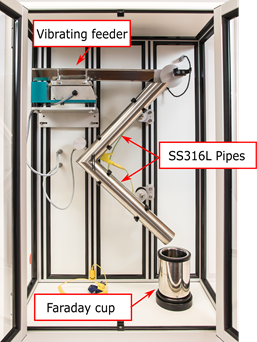
Figure 1: GranuCharge picture
The LMD Machine
For this study, a BEAM Modulo 400 LMD machine has been used. In the machine, the powder endures different stages of conveying, presented in Figure 2. First, the powder flows out of the powder distributor and is conveyed to the nozzle. Then the powder flows through the nozzle and is melted by the Laser before being deposited. Each of these stages may lead to an increase in powder charge density due to tribo-charging.
In this study, an Inconel 718 (Nickel alloy) has been used.
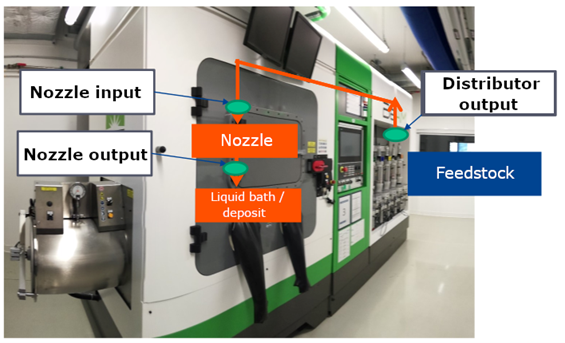
Figure 2: BEAM Modulo 400 used in this study
GranuCharge Analysis
Experimental Protocol
Powder charge density has been measured with the GranuCharge at the three process stages of interest (distributor output, before the nozzle, after the nozzle). During a measurement, the powder is directly poured into the GranuCharge cup by the machine tubes (Figure 3). For this purpose, an extension has been used to move the faraday cup outside of the GranuCharge. The total charge and the mass that arrived inside the cup are accurately measured. The distributor speed is initially set at 0.68 rpm, 20% of the maximal speed (3.4 rpm), and will then be varied to investigate its influence on charge build-up inside the powder.
LEARN MORE ABOUT THE GRANUCHARGE
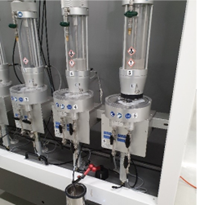 |
 |
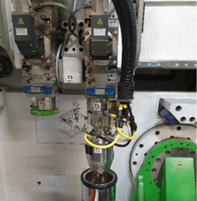 |
| Powder distributor | Before nozzle | After nozzle |
Figure 3: Printer locations at which the powder charge density is measured
Figure 4 presents the measured powder charge density at the different stages of the process. At the output of the distributor, the powder exhibits a charge density of 0.39 nC/g indicating that the flow through the distributor leads to a charge build-up inside the powder. However, the charge density of the powder just before the nozzle is significantly decreased. A charge dissipation during the conveying through the pipe from the distributor to the nozzle thus takes place. Finally, the flow through the nozzle further dissipates the charges, leading to a slightly negative charge density at the output.
Interestingly, we observe that the conveying of the powder through the pipes and the nozzle is beneficial regarding the tribo-charging as it contributes to the dissipation of electrostatic charges. The distributor is clearly identified as the part of the process that leads to a charge build-up.
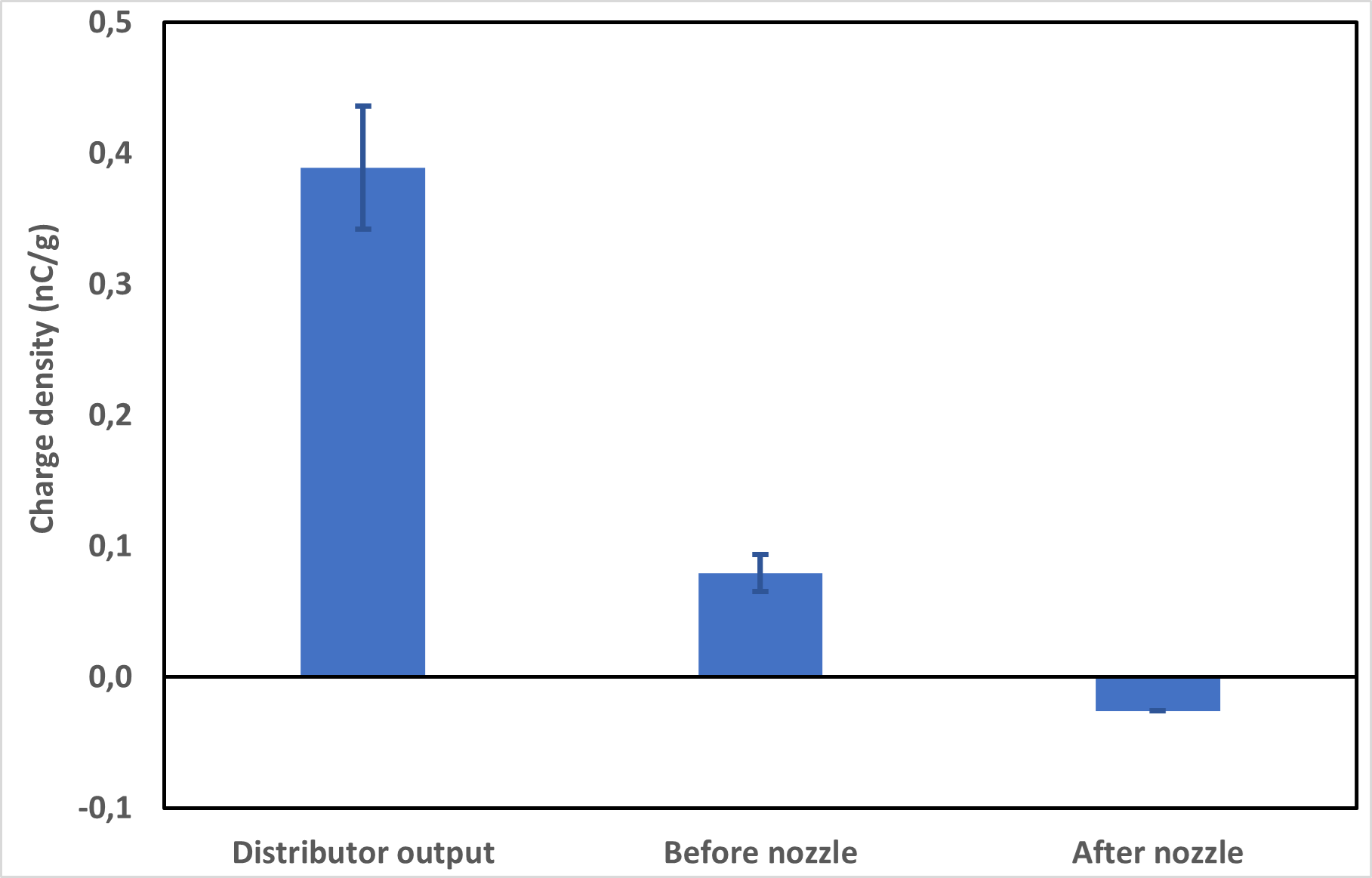
Figure 4: Measured charge density at the different process locations
To investigate more deeply the influence of the distributor on the charging of the powder, measurements have been performed at different distributor speeds. Figure 5 presents the charge density measured with the GranuCharge for several distributor speeds, ranging from 10% to 30% of the maximal distributor speed (3.4 rpm). Based on these results, it appears that the distributor speed has a significant influence on the charge build-up inside the powder. The higher the speed the higher the charge density of the powder at the output of the distributor. The best linear fit of the data is depicted in Figure 5. A linear evolution of the charge density with the distributor speed is obtained for the range of investigated speeds. Therefore, a powder processed at high distributor speed is expected to exhibit an electrostatic related decrease of performance in the printer.
LEARN MORE ABOUT THE GRANUCHARGE
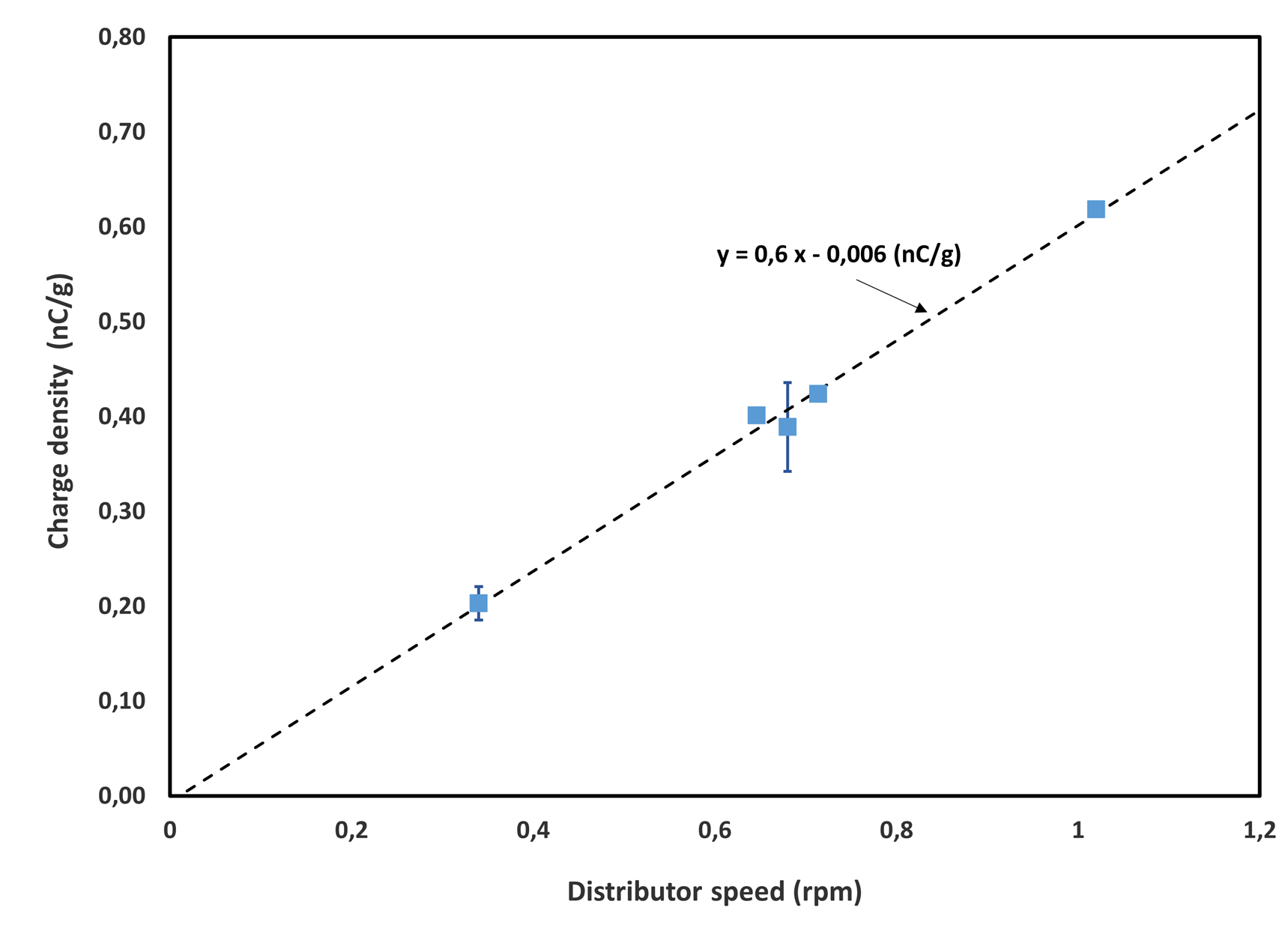
Figure 5: Influence of the distributor speed on the powder charge density. Dashed line represents the best linear fit of the data
Conclusion
The influence of the powder conveying in a LMD process on the charge build-up of an Inconel 718 powder has been investigated with the GranuCharge instrument. The charge density of the powder has been measured at the output of the distributor, after the conveying from the distributor to the nozzle, and after the flow through the nozzle. The main results are:
- The distributor leads to a charge build-up of the powder.
- The higher the distributor speed the higher the charge density of the output powder.
- The conveying to the nozzle and the nozzle itself contribute to a decrease in the charge density.
The GranuCharge instrument allows conducting precise investigations of the electrostatic charging of powders at different points of the process. This opens up new optimization perspectives regarding electrostatic charging avoidance during the process.
Acknowledgments
GranuTools thanks Guillaume Marion from Safran who performed the GranuCharge measurements on the LMD machine.
References
Cascade of granular flows for characterizing segregation, G. Lumay, F. Boschin, R. Cloots, N. Vandewalle, Powder Technology 234, 32-36 (2013).
Combined effect of moisture and electrostatic charges on powder flow, A. Rescaglio, J. Schockmel, N. Vandewalle and G. Lumay, EPJ Web of Conferences 140, 13009 (2017).
Compaction dynamics of a magnetized powder, G. Lumay, S. Dorbolo and N. Vandewalle, Physical Review E 80, 041302 (2009).
Compaction of anisotropic granular materials: Experiments and simulations, G. Lumay and N. Vandewalle, Physical Review E 70, 051314 (2004).
Compaction Dynamics of Wet Granular Assemblies, J. E. Fiscina, G. Lumay, F. Ludewig and N. Vandewalle, Physical Review Letters 105, 048001 (2010).
Effect of an electric field on an intermittent granular flow, E. Mersch, G. Lumay, F. Boschini, and N. Vandewalle, Physical Review E 81, 041309 (2010).
Effect of relative air humidity on the flowability of lactose powders, G. Lumay, K. Traina, F. Boschini, V. Delaval, A. Rescaglio, R. Cloots and N. Vandewalle, Journal of Drug Delivery Science and Technology 35, 207-212 (2016).
Experimental Study of Granular Compaction Dynamics at Different Scales: Grain Mobility, Hexagonal Domains, and Packing Fraction, G. Lumay and N. Vandewalle, Physical Review Letters 95, 028002 (2005).
Flow abilities of powders and granular materials evidenced from dynamical tap density measurement, K. Traina, R. Cloots, S. Bontempi, G. Lumay, N. Vandewalle and F. Boschini, Powder Technology, 235, 842-852 (2013).
Flow of magnetized grains in a rotating drum, G. Lumay and N. Vandewalle, Physical Review E 82, 040301(R) (2010).
How tribo-electric charges modify powder flowability, A. Rescaglio, J. Schockmel, F. Francqui, N. Vandewalle, and G. Lumay, Annual Transactions of The Nordic Rheology Society 25, 17-21 (2016).
Influence of cohesives forces on the macroscopic properties of granular assemblies, G. Lumay, J. Fiscina, F. Ludewig and N. Vandewalle, AIP Conference Proceedings 1542, 995 (2013).
Linking compaction dynamics to the flow properties of powders, G. Lumay, N. Vandewalle, C. Bodson, L. Delattre and O. Gerasimov, Applied Physics Letters 89, 093505 (2006).
Linking flowability and granulometry of lactose powders, F. Boschini, V. Delaval, K. Traina, N. Vandewalle, and G. Lumay, International Journal of Pharmaceutics 494, 312–320 (2015).
Measuring the flowing properties of powders and grains, G. Lumay, F. Boschini, K. Traina, S. Bontempi, J.-C. Remy, R. Cloots, and N. Vandewalle, Powder Technology 224, 19-27 (2012).
Motion of carbon nanotubes in a rotating drum: The dynamic angle of repose and a bed behavior diagram, S. L. Pirard, G. Lumay, N. Vandewalle, J-P. Pirard, Chemical Engineering Journal 146, 143-147 (2009).
Mullite coatings on ceramic substrates: Stabilisation of Al2O3–SiO2 suspensions for spray drying of composite granules suitable for reactive plasma spraying, A. Schrijnemakers, S. André, G. Lumay, N. Vandewalle, F. Boschini, R. Cloots and B. Vertruyen, Journal of the European Ceramic Society 29, 2169–2175 (2009).
Rheological behavior of β-Ti and NiTi powders produced by atomization for SLM production of open porous orthopedic implants, G. Yablokova, M. Speirs, J. Van Humbeeck, J.-P. Kruth, J. Schrooten, R. Cloots, F. Boschini, G. Lumay, J. Luyten, Powder Technology 283, 199–209 (2015).
The flow rate of granular materials through an orifice, C. Mankoc, A. Janda, R. Arévalo, J. M. Pastor, I. Zuriguel, A. Garcimartín and D. Maza, Granular Matter 9, p407–414 (2007).
The influence of grain shape, friction and cohesion on granular compaction dynamics, N. Vandewalle, G. Lumay, O. Gerasimov and F. Ludewig, The European Physical Journal E (2007).


